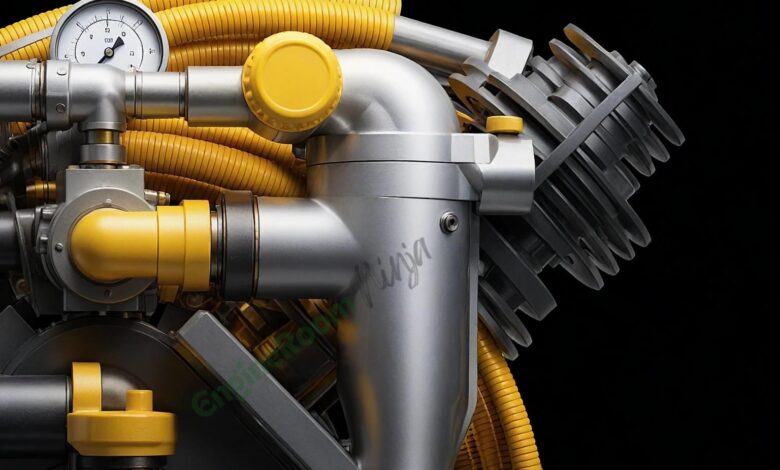What Every Fourth Engineer Needs to Know About the Sperre Air Compressor

So, You Want to Know About the Sperre Main Air Compressor? Welcome to the Most “Exciting” Engineering Tour Ever! 🚀
Let me guess, you’re here because someone told you that as a fourth engineer, you need to know everything about the Sperre main air compressor. Thrilling, isn’t it? Let’s dive in, and by the end of this, you’ll not only know the ins and outs of this magical air-blowing machine but also probably question your career choices. 🎉
Introduction: Why Learn About This Beast?
Because compressors are the rockstars of a ship’s engine room! Except instead of loud guitars, they make loud noises while ensuring compressed air is available for starting engines, running pneumatic tools, and generally keeping things ship-shape. Also, if you don’t, you’ll be that person frantically Googling “how does an air compressor work?” mid-shift. 👀
Safety Precautions (Because We Care About Your Eyebrows)
- Don’t touch stuff unless you’re sure what it is: That “innocent-looking” part might be hotter than your morning coffee. ☕🔥
- High-pressure = high drama: If something bursts, it’s not a party—it’s an emergency.
- Oil spills = slip-n-slide: Unless your dream is to star in a live-action slapstick comedy, clean up that lube oil.
Let’s Break Down the Sperre HP 200 Main Air Compressor (No, Not Literally)
Here’s a sarcastic step-by-step tour of this marvel of engineering:
1. Suction Filter (The Air’s Gateway Drug)
The air starts its magical journey here, where it gets sucked in from the atmosphere. This filter is like the bouncer at a nightclub, keeping out the riffraff (dust and debris).
2. Low-Pressure Stage (Baby Steps)
- The air first enters the low-pressure suction valve.
- Then it’s “gently” compressed to about 7 bar (just a little squeeze, no biggie) and sent to the low-pressure discharge valve.
- Afterward, it heads to a cooler, because even air needs to chill sometimes. ❄️
3. High-Pressure Stage (The Big Guns)
- Post-cooling, the air enters the high-pressure suction valve, where it’s ready for the heavy-duty stuff.
- Here, it gets squished up to 30 bar and is finally sent to another cooler. More chilling. Because hot air isn’t trendy. 😎
4. Safety Features (Or How Not to Blow Things Up)
- Safety Valves: These are the compressor’s version of “don’t panic” buttons. One for low pressure, one for high pressure. Notice how the high-pressure one is beefier? That’s because 30 bar means business. 💪
- Bursting Disc: If things get too intense, this disc pops, letting out water. Think of it as the compressor’s way of crying for help. 😭
5. Lube Oil System (The Unsung Hero)
- The lube oil pump takes oil from the sump, filters it, and ensures everything stays nice and slippery.
- A low lube oil pressure switch exists to trip the compressor if the pressure dips. Because no oil = bad day.
6. Temperature and Pressure Switches (The Snitches)
- High-Pressure Temperature Switch: If things get too hot, this tattletale lights up to warn you that the cooler isn’t doing its job.
- Pressure Gauges: These measure air pressure at different stages. Don’t ignore them unless you enjoy troubleshooting.
7. Motor and Coupling (The Dynamic Duo)
- The motor and compressor are connected by an elastic coupling, which is as fancy as it sounds. It’s like teamwork but for machines.
8. Water Cooling System (Stay Hydrated!)
- Pipes bring water in and out to keep everything from overheating. A thermometer checks the water temperature because someone’s gotta monitor it. 🌡️
Common Mistakes (aka How to Look Like a Rookie)
- Ignoring the filters: Unless you love clogs and inefficiency, keep those suction filters clean.
- Skipping oil checks: Low oil = fried compressor. Don’t let that happen.
- Mishandling the safety valves: These are not playthings. Don’t test your luck—or your patience.
- Overlooking temperature gauges: Hot air might sound harmless, but trust me, it’s not.
Conclusion: You Made It! 🎉
Congratulations, you now know more about the Sperre HP 200 than you ever thought you wanted to. Will this knowledge make you the life of the party? Probably not. But it will save you from awkwardly fumbling during an engine room inspection.
So, next time someone says, “Hey, what’s that thing?” you can confidently reply, “Oh, that? Just the low-pressure suction valve doing its thing. No biggie.” And walk away like the engineering rockstar you are. ✌️
Questions? Doubts? Existential crises? Drop them in the comments—or, you know, your chief engineer’s inbox.

